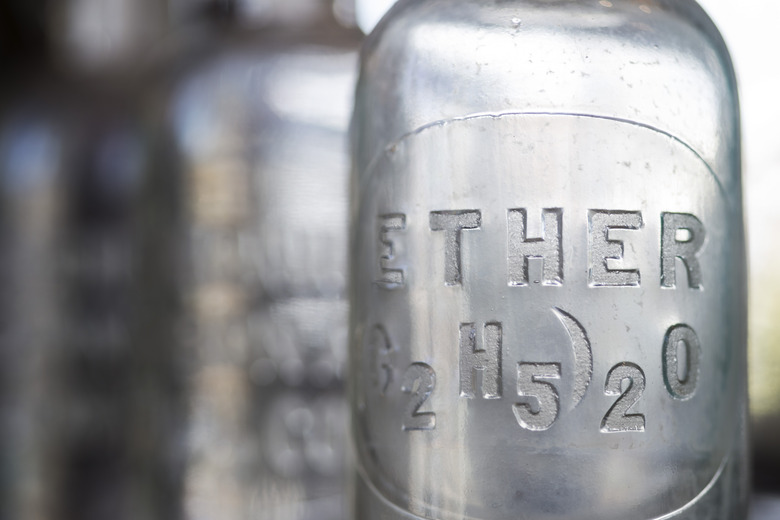Differences Between Petroleum Ether & Diethyl Ether
The similar names of petroleum ether and diethyl ether are a frequent source of confusion in labs and other places that use chemicals. Despite the common "ether" designation, these are two very different chemicals. It's worth understanding the difference between the two since, other than both being chemical solvents, they have little in common and cannot be interchanged.
Chemical Differences
Chemical Differences
Diethyl ether is an organic chemical with the formula CH3CH2OCH2CH3. It is truly an ether, in the language of organic nomenclature, since it has an oxygen atom with carbons on either side, which is the criteria for the ether classification. Strangely, petroleum ether is not an ether and, in fact, it is not even a single chemical. It is a mixture of various organic compounds made from carbon and hydrogen, including pentane and hexane.
Physical Properties
Physical Properties
Diethyl ether is a clear, colorless liquid at room temperature. It freezes at -116 degrees Celsius and boils at 35 degrees. Its vapors have a somewhat sweet smell and are heavier than air. It is highly flammable, even at sub-zero temperatures. Petroleum ether is also a colorless liquid and boils at a similar temperature of 38 degrees Celsius. Its fumes have an odor more like gasoline. It is also flammable and produces enough vapors to become a fire hazard at temperatures as low as -18 degrees.
Toxicology
Toxicology
Diethyl ether is toxic, although it has been used in the past to deaden pain during operations. It produces irritation of the eyes, skin or lungs. Inhalation of large amounts can cause loss of consciousness and ingestion can lead to nausea or even coma. Long-term exposure leads to liver damage. Petroleum ether is also an irritant and can produce coma by ingestion or inhalation. It has also been found to be an animal carcinogen.
Exposure Limits
Exposure Limits
Inhalation of 3400 parts per million (ppm) petroleum ether in air for four hours has been shown to be fatal to rats. A substantially higher level of diethyl ether—31,000 ppm—was fatal to mice, although over only half an hour. The U.S. National Institute of Occupational Safety and Health (NIOSH) has an exposure limit set of 1900 ppm for diethyl ether, which they consider immediately dangerous. NIOSH allows exposure to petroleum ether at average levels of approximately 350 ppm throughout the workday.
Cite This Article
MLA
Judge, Michael. "Differences Between Petroleum Ether & Diethyl Ether" sciencing.com, https://www.sciencing.com/differences-petroleum-ether-diethyl-ether-8791792/. 13 March 2018.
APA
Judge, Michael. (2018, March 13). Differences Between Petroleum Ether & Diethyl Ether. sciencing.com. Retrieved from https://www.sciencing.com/differences-petroleum-ether-diethyl-ether-8791792/
Chicago
Judge, Michael. Differences Between Petroleum Ether & Diethyl Ether last modified August 30, 2022. https://www.sciencing.com/differences-petroleum-ether-diethyl-ether-8791792/
